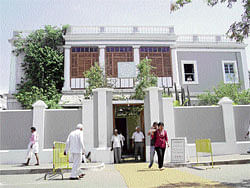“When you pick a rose, there are a few thorns,” sighs a soft-spoken, self-effacing resident at the Sri Aurobindo Ashram here, as an aesthetically done pathway leads you to a rectangular courtyard where the bodies of Sri Aurobindo and the Mother have been laid to rest.

The scorched sensation that the summer sun brings and sharp twitters of birds does not diminish one bit the profound solemnity that etherises the “Samadhi” of the late patriot and philosopher encased by white-marble. Lyrical floral patterns adorn its top, even as devotees dip into a brass cup of sacred water at the other end.
There lies the mother’s mortal remains, too. She was born Mirra Alfassa in Paris, before she first met Aurobindo in Pondicherry in 1914 and subsequently became his ardent disciple, virtually taking charge of everything. Under her devoted gaze, the ashram has grown since 1926 to help concretise his vision of a new “integral yoga” for humanity’s greater benefit.
But nothing captured the present mood in the ashram more poignantly and pithily than the resident’s remark, as one major phase of a controversy--since the Columbia University Press, New York, had published a 500-page masterly biography of one of India’s greatest sons, titled The Lives of Sri Aurobindo in 2008 by American historian Peter Heehs--has just ended.
The rose, as fresh as ever, is undoubtedly the rich political-nationalist, literary, philosophical and spiritual legacy Aurobindo had left. And for Peter Heehs, who was deeply influenced by the Master’s yoga and did stints of odd jobs, including as a taxi driver in New York, to earn for his air ticket to Pondicherry, retelling the saint’s life to a western audience could not be another “hagiography”, a genre, he says, “is very much alive in India.”
The latest biography by Peter Heehs, himself an ashram member since 1971 and one of those persons who painstakingly organised the Aurobindo archives there, was objectively commended by another noted historian Ramachandra Guha, as a product of “lifetime scholarship”. It had the added authenticity for “Heehs knows the documentary evidence on and around Sri Aurobindo’s life, better than anyone else,” wrote Guha hailing it.
“I wrote the book from 2002 to 2006 and it took two years to get the book accepted (for publishing),” Heehs told Deccan Herald in an extensive interview in Pondicherry, a few days before the Home Ministry extended his visa by a year from April 15 that set at naught several uncertainties for now.
But shortly after the book came hot from the Columbia University Press in August-September 2008, Heehs found the satisfaction from his long years of labour in presenting Aurobindo’s many-sided life “to a very serious audience” to be so short-lived as a “small coterie” of people connected to the ashram soon began a relentless campaign against Heehs, dubbing it “blasphemous”.
Apparently, some passages in the book–one allegedly suggesting a romantic ring to the Aurobindo-Mother relationship, and some discussions of an “element of lunacy” that ran in Aurobindo’s family--triggered a full-scale tirade against the biography even before it could be published in India.
Sources in the Sri Aurobindo Ashram Trust said,on condition of anonymity that a few “ambitious” past and present residents were behind the campaign, charging Heehs with “denigrating” Aurobindo’s memory that hurt people’s sentiments and even pressured the Ashram to ‘throw out’ Heehs.
Pulling out some extracts from the book which they found “objectionable”, this coterie circulated it all over to “create an impression that followers of Sri Aurobindo wanted this book banned.” It took a bizarre turn as one of them also filed a petition in the Odisha High Court–as the pan-Indian Aurobindo is held in greater reverence in that State in particular--to ban its printing/publication and distribution in India.
The Odisha Government in April 2009 even issued a “gazette” that any “copies, reprints, translations or other documents containing extracts taken from there be forfeited to the Government.” While Heehs has challenged this notification in the Odisha High Court, which is pending, an Indian reprint of The Lives of Sri Aurobindo is just not possible until the case is decided. The irony is that those clamouring for the book’s ban “could not have read the book for it is not available in India, which itself betrayed their personal agenda,” said a senior ashram member. Though some may “dislike” the book for its style and contents, the ashram trust has received a large number of communications from eminent persons who have appreciated Heehs’ biography as an objective work by a serious historian. The ashram, distancing itself from the “fundamentalists”, took a firm stand that it will not expel Heehs, much less “dictate” to Aurobindo’s followers and others what “they should read and what they should not read”. Yet, it legally left the issue of his visa extension to the Central Government. Any ban on the book would not only be against the basic freedom of expression, but will militate against Aurobindo’s free spirit, many felt.
Heehs himself was categorical as he explained line by line to show how on both the issues raised by his detractors, “there is no suggestion of any improper relation between Sri Aurobindo and the Mother.”
Regarding Aurobindo’s alleged madness, “the fundamentalists charge is ridiculous; they only have to read three pages of the book and my conclusion is that he is eminently sane,” Heehs said, refuting the other part of the controversy, too, which deals with the relationship between genius and mental instability, discussed over many centuries from Plato to Sigmund Freud.
As the tussle raged, what shocked the ashram was the dissenters using this book row as a “ruse to take over the ashram itself”. Their efforts at an “internal coup” would have been emboldened if the Home Ministry had rejected Heehs’ visa extension bowing to “fundamentalists demand”. That luckily did not happen for now, raising hopes in the ashram to continue Aurobindo’s legacy of finding one’s path freely to the “Divine Life”.